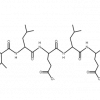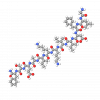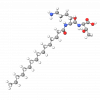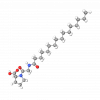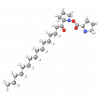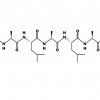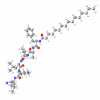Peptides
There are numerous examples in physiology of peptide regulatory elements that play integral roles in basic homeostatic mechanisms such as injury-repair responses and other stimulus-response actions. Among these are well-known neuropeptides (e.g., bradykinins, endorphins); metabolism and fat storage regulators (e.g., neuropeptide Y, leptin, insulin); tanning and skin pigmentation-related peptides (e.g., α-MSH, ACTH, Agouti), and peptides involved in wound healing (e.g., FGF).
This large group of innovative cosmeceutical ingredients triumphed in the world of skincare products during the last two decades. Peptides are chains of amino acids that are attached in a specific order. Amino acids are naturally occurring in the body and are vital to everyday living processes. Peptides can be made up of 2 or more amino acids that can stimulate different responses within the body. As a result, peptides serve as tiny messengers that can be sent to kick the skin into gear and make it look better.
Peptides are leading a beauty revolution due to their excellent multi-functional properties; formularies are scrambling to access the latest advances in cosmetic peptide technology. In addition, their "Botox-like" performance, activation of collagen and elastin production, and skin-lightening effect make them very efficient against coarse wrinkles and hyperpigmentation of the skin.
Oligopeptide-51 is a synthetic multifunctional peptide known under the trade name CG-Purilux a “Golden key” of skin bioregulation. It regulates two areas of skin rejuvenation and health at once: melanin formation and fat metabolism.
Oligopeptide-54 is a synthetic peptide known under the trade name CG-Nokkin that acts as a blocker of the BMP receptor, which includes the synthesis of DKK-1, a key molecule of androgenetic alopecia.
Oligopeptide-55 is a synthetic 12 amino acid long peptide that boosts keratinocytes and fibroblasts proliferation and collagen and elastin production improving skin elasticity and resilience. This peptide is also known under the trade name CG-Collagrin.
Oligopeptide-57 is a synthetic biomimetic peptide that promotes the proliferation of dermal keratinocytes and fibroblasts. This peptide is also known under the trade name CG-Beutilin.
Oligopeptide-6 is a biomimetic synthetic peptide that repeats a part of the sequence of Laminin-5 and mimics its action on skin cells. It interacts with integrins and receptors on skin cell surfaces, promoting their adhesion and migration.
Oligopeptide-62 is a synthetic peptide known under the trade name CG-Liftin that stimulates the proliferation of fibroblasts and activates the synthesis of collagen and fibronectin.
Oligopeptide-68 reduces tyrosinase that lessens melanin production, fighting against melasma, hyperpigmentation, and dark spots.
Oligopeptide-71 is a synthetic biomimetic peptide that repeats a ligand binding part of a sequence of the EDA1 (Ectodysplasin) protein that attaches to the Ectodysplasin A receptor (EDAR) responsible for the development of the skin of an embryo. It is known under the trade name CG-Edrin.
Oligopeptide-72 is a synthetic biomimetic peptide that boosts the proliferation and morphological changes of dermal fibroblasts exposing lifted, healthy, and youthful skin appearance. This peptide is also known under the trade name CG-Boostrin.
Oligopeptide-73 is a synthetic peptide known under the trade name CG-EPG that triggers the proliferation of keratinocytes and fibroblasts, protects fibroblasts from oxidative stress, and blocks apoptosis.
Oligopeptide-76 is a synthetic biomimetic 13 amino acid long peptide, an analog of natural Aurein 1.2 peptide produced in the skin of the Litoria Aurea frog.
Pal-KT (Palmitoyl Dipeptide-7) is the shortest matrikine lipo-peptide with anti-aging action that repeats the part of the sequence (palmitoyl-lysine-threonine) of the famous Matrixyl™ pentapeptide (Pal-KTTKS) and exhibits similar properties, boosting extracellular matrix (ECM) components producti
Palmitoyl Dipeptide-10 is a synthetic lipopeptide (Sequence Pal-Ala-His) with Carnosine-like action. It is also known under the trade names SunPEP Di-100 and C-Pep™.
Palmitoyl Dipeptide-17 (Palmitoyl Glycylproline) is a synthetic lipopeptide with the sequence Pal-Gly-Pro. It is known under the trade name Proliphil.
Palmitoyl Dipeptide-52 is a simple lipopeptide with sequence Pal-Pro-Pro known under the trade name Silverfree™ developed by Sederma. It is a pro-pigmenting peptide that stimulates the repigmentation of hair.
An innovative peptide binds neurons and blocks the neuromuscular connection, providing a Botox-like effect with minimal concentrations and without injections.
Palmitoyl Heptapeptide-27 is a synthetic biomimetic lipo-peptide that boosts the production of filaggrin and loricrin proteins involved in barrier function and many other processes in the skin including natural moisturizing factors (NMF) production, pH balancing, and homeostasis.
Palmitoyl Hexapeptide-12, also known as Biopeptide El™, is a conjugate of Palmitic acid and a peptide with a sequence Val-Gly-Val-Ala-Pro-Gly, known as a fragment of the protein called elastin.
Palmitoyl Hexapeptide-14 (former Palmitoyl Hexapeptide-6) is a short bioactive peptide with a lipid delivery system for deeper penetration into the skin. It is an anti-aging lipo-peptide that stimulates skin the proliferation of dermal fibroblast cells boosting collagen production.
Palmitoyl Hexapeptide-26 is a synthetic lipopeptide with antimicrobial, skin-calming, and redness-reducing properties. It is also known under the trade name Shield Bact Peptide.
Palmitoyl Hexapeptide-52 is a synthetic lipopeptide that inhibits acetylcholine release into the synaptic cleft and expression muscle contractions.
Palmitoyl Octapeptide-24 is a synthetic guiding lipo-peptide that can bind to specific receptors on keratocytes like a key and lock.
Palmitoyl Octapeptide-26 stimulates collagen and elastin production, enhancing the effectiveness of Heptapeptide-15 palmitate in FibroBoost® Complex.
Palmitoyl Oligopeptide-78 is a synthetic biomimetic lipo-peptide that stimulates keratin production by keratinocytes, enhancing epidermis thickness, lessening transdermal moisture loss, and enhancing the barrier function of the skin.
Palmitoyl sh-Octapeptide-24 Amide is a lipo-peptide derived from palmitic acid and a synthetic analog of a human peptide that inhibits the expression of genes responsible for tyrosinase enzyme production. The Lipophile part (palmitic) provides stability and improves delivery.
Palmitoyl sh-Tetrapeptide-2 Amide is a lipo-peptide that inhibits interleukin-1R, an inflammatory cytokine receptor, soothing skin irritation and acting as an anti-inflammatory agent. It is known under the trade name Ilonerin™.
Palmitoyl sh-Tripeptide-1 Amide is a low molecular weight synthetic recombinant lipo-peptide derived from FGF-1 (fibroblast growth factor -1) that is involved in various cellular processes, including angiogenesis, keratinocyte organization, and wound healing.
Palmitoyl sh-Tripeptide-2 Amide is a low molecular weight lipo-peptide derived from Tumor Necrosis Factor Receptor (TNFR) that inhibits TNF-α ( tumor-necrosis factor-α). It is known under the trade name Tenefrin™.
Palmitoyl sh-Tripeptide-3 Amide is a low molecular weight lipo-peptide derived from Epidermal Growth Factor (EGF) that stimulates cell growth, proliferation, and differentiation by binding to its receptor EGFR. It is also known under the trade name Synepin™.
